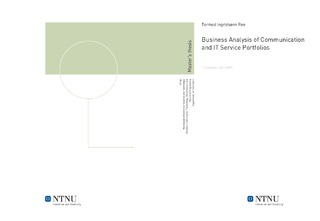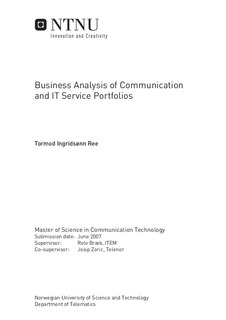| dc.description.abstract | The last decades in the communication and IT industry have been influenced by the introduction of numerous new business actors and technological systems. They have brought with them a wide variety of business actors operating on different levels of the value chain, or together in complex value constellations. Old platform specific standards have started to fade away, and new platforms with more streamlined layers have appeared. These new platforms are part of the Next Generation Network (NGN). Services of this network utilize a number of service enablers. The new service platforms deliver services to the end user as a set of service portfolios. The new NGN communication and IT services are heterogeneous in two ways; technologically and business-wise. Technologically, they consist of pervasive and ubiquitous services, run by heterogeneous and distributed service platforms. Business-wise, multiple business actors with a variety of business models cooperate to produce the services. Valuation of these new heterogeneous NGN communication and IT services has proved to be challenging. Forecasting of demand and acceptance is difficult due to limited historical experience. The interacting business actors and their variety of business actors also bring with them conflicts of interest. In addition to the challenge of getting their technical systems to work together, they have to agree on a revenue share agreement to share the revenue from the co-produced services. The purpose of this thesis has been to perform a business analysis of a communication and IT service portfolio, with an emphasis on business actor positions and incentives. To make well informed investment decision regarding such service portfolios, it is vital to valuate the projects quantitatively. To account for and compare different business situations and market development, scenarios are used. These scenarios need to describe business actor relations and strategies. This thesis proposes a quantitative model framework (CF model) for the analysis of a communication and IT service portfolio. The model is based on the work of Langøygard (2006) and Zoric & Lassen (2005). Relevant technical and economic theory is researched to provide a sound background for the model. Two new aspects are included in the model; bargaining power and revenue share. The model developed evaluates a content provisioning portfolio, where the bargaining power of the content providers is important to the outcome of the project. This bargaining power is important because it decides the price of the service enablers provided by the content providers. The revenue share agreement is important because it decides each business actor s share of the revenue from the services sold, and because it affects the incentives of all business actors. A proof-of-concept test is conducted to test the functionality of the model and to investigate the profitability of the service portfolio subject to valuation. The test shows that the model functions as intended, accounting for aspects such as user acceptance, demand, market development, and the relation between business actors. The results from the model suggest that the valuated service portfolio is profitable to all business actors for most of the market developments. The results also show that the content providers are better off when their concentration is low and when they have built up barriers to entry by participating in the service platform cooperation. This is because these factors increase their bargaining power and enables them to charge a higher mark up over marginal cost. This higher mark up more than outweighs the costs of participating in the service platform. The model results also show that a solution acceptable to most business actors can be reached with most of the scenarios. The scenarios include a net present value threshold for some business actors to account for strategic considerations. The new revenue share functionality has to redistribute the revenue in some of the original solutions to reach a feasible solution. Furthermore, the new revenue share functionality is shown to align the incentives of the participating business actors. | nb_NO |

